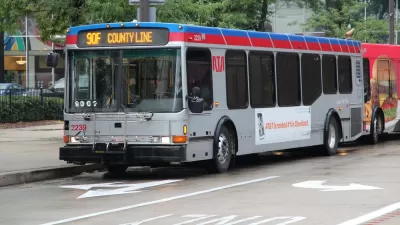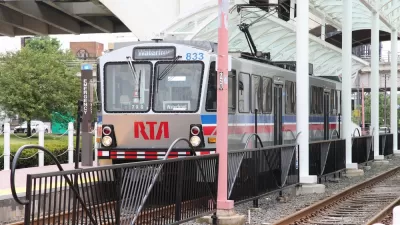The Greater Cleveland Regional Transit Authority's Waterfront rail line carries 400 riders a day. As the authority struggles to fill a $7 million budgetary gap, is it time to finally bury the unused line?

Tim Kovach explores the implications of a recent decision to raise fares on the Greater Cleveland Regional Transit Authority (GCRTA) system in light of a $7 million budget shortfall. The GCRTA Board of Trustees recently "approved a series of stepwise fare increases that will take effect on August 16, which should increase annual operating revenues by $3.5 million. Single-ride fares will increase to $2.50 from $2.25 currently and, ultimately, rise again to $2.75 in August 2018. All day passes will increase from $5 to $5.50 and ultimately $6, while monthly passes will jump from $85 to $95 and then $105."
Not only do those fare increases mean "Cleveland’s fares are now on par with, or even higher than, some of the most extensive transit systems in the country," writes Kovach, they also won't cover the extent of the deficit.
Which brings Kovach to the debate over what to do with the GCRTA's "Ghost Line"—officially known as the Waterfront rail line, "which ferries customers from the Tower City transit hub along the Cuyahoga River and lakefront to the South Harbor," carrying 400 passengers a day and an average of two riders per off-peak train.
The main theme of the article is what exactly to do about the Ghost Train, in light of development expectations along the line as well as sunk cost (the line cost $50 million to construct and opened in 1996). Kovach recommends a few steps planners and local officials should take to determine the future of the line.
FULL STORY: Asking some lingering questions about cutting service on the Waterfront Line

Alabama: Trump Terminates Settlements for Black Communities Harmed By Raw Sewage
Trump deemed the landmark civil rights agreement “illegal DEI and environmental justice policy.”

Planetizen Federal Action Tracker
A weekly monitor of how Trump’s orders and actions are impacting planners and planning in America.

The 120 Year Old Tiny Home Villages That Sheltered San Francisco’s Earthquake Refugees
More than a century ago, San Francisco mobilized to house thousands of residents displaced by the 1906 earthquake. Could their strategy offer a model for the present?

Ken Jennings Launches Transit Web Series
The Jeopardy champ wants you to ride public transit.

BLM To Rescind Public Lands Rule
The change will downgrade conservation, once again putting federal land at risk for mining and other extractive uses.

Indy Neighborhood Group Builds Temporary Multi-Use Path
Community members, aided in part by funding from the city, repurposed a vehicle lane to create a protected bike and pedestrian path for the summer season.
Urban Design for Planners 1: Software Tools
This six-course series explores essential urban design concepts using open source software and equips planners with the tools they need to participate fully in the urban design process.
Planning for Universal Design
Learn the tools for implementing Universal Design in planning regulations.
Clanton & Associates, Inc.
Jessamine County Fiscal Court
Institute for Housing and Urban Development Studies (IHS)
City of Grandview
Harvard GSD Executive Education
Toledo-Lucas County Plan Commissions
Salt Lake City
NYU Wagner Graduate School of Public Service





























